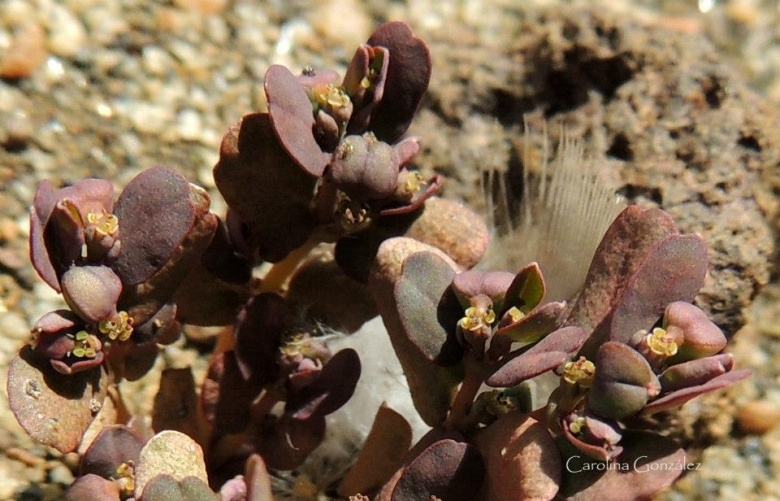Accepted Scientific Name: Euphorbia klotzschii Oudejans
Phytologia 67: 46 1989

Euphorbia ovalifolia (Euphorbia klotzschii) Photo by: Carolina González
Neuquén province, Argentina. This plant is fairly common here. The white sap (latex) is used in herbal medicine for insect bites.
Origin and Habitat: Argentina (Buenos Aires, Catamarca, Chaco, Córdoba, Corrientes, Entre Ríos, Formosa, Jujuy, La Pampa, La Rioja, Mendoza, Misiones, Neuquen, Río Negro, Salta, Sgo. del Estero, Santa Fe, San Juan, San Luis, Tucumán) Chile (Región I, Región II, Región III, Región IV, Región V, Región VI, Región VII, Región VIII, Región IX, Región Metropolitana de Santiago), Paraguay (Alto Paraguay, Ñeembucú, Paraguarí), and Uruguay (Montevideo).
Altitude range: It grows at low and medium altitude, from sea level to 2100 metres above sea level.
Habitat and ecology: Euphorbia klotzschiiSN|31046]]SN|31046]] is locally common in dry sclerophyllous woodlands and shrublands.
Synonyms:
See all synonyms of Euphorbia klotzschii
back
Accepted name in llifle Database:Euphorbia klotzschii OudejansPhytologia 67: 46 1989Synonymy: 15
back
Common Names include:
SPANISH (Español): Leche, Pasto leche, Pasto lechero, Verdulaga, Lecheleche, Lecherito del campo, Tupasú cambú, Potrillo cimarrón, Pichoguilla
Description: Euphorbia klotzschiiSN|31046]]SN|31046]] is an annual herb with leaves showing a certain degrees of succulence. When the plant blooms the foliage often becomes tinged with dark red or purplish hues. Many of the popular names of this weed such as: Leche, Pasto leche, Pasto lechero, Lecheleche, Lecherito del campo, refer to the latex or milk (leche in Spanish ) produced by the plant. That milk is used to heal wounds and remove skin warts. It is also used to relieve itching from insect bites. It is said that in Chile the Euphorbia klotzschiiSN|31046]]SN|31046]] is consumed as salad and soup, but this data may be misleading, since other species of the genus are poisonous. However, for the traditional traditional Atacama cuisine (cocina tradicional atacameña), recipes for "purslane salad" with potatoes are documented. Information about the use of this species for forage, provided by some informants contradict the observations of others according to which it is a bitter weed avoided by animals.
Derivation of specific name: klotzschii: the epithet honours the German pharmaceutical, zoologist, botanist and mycologist; Johann Friedrich Klotzsch (1805-1860), who collected the plant in Argentina.
More...Bibliography: Major references and further lectures
1) Carolina Villagrán M., Victoria Castro R. “Ciencia indígena de los Andes del norte de Chile” Editorial Universitaria, 2003
2) Euphorbia klotzschii. (2014, 14 de noviembre). Wikipedia, La enciclopedia libre. Fecha de consulta: 20:34, abril 16, 2015 desde http://es.wikipedia.org/w/index.php?title=Euphorbia_klotzschii&oldid=78149719.
3) Catálogo de las Plantas Vasculares “Euphorbia klotzschii Oudejans var. klotzschii” Instituto de Botánica Darwinion - IBODA 2014 web <http://www2.darwin.edu.ar>
4) SciELO Argentina “APPENDIX I. Checklist of the native medicinal plants from Argentina1.” - Kurtziana vol. 34 no. 1-2 http://www.scielo.org.ar/img/revistas/kurtz/v34n1-2/app1.htm
More...Cultivation and Propagation: This species is not known in cultivation.










